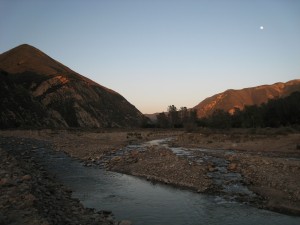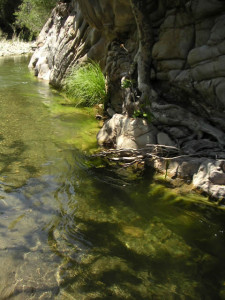The bill seeks to preserve the special character and free-flowing condition of 158.5 miles of rivers and creeks in the Los Padres National Forest—some of which are the last non-channelized and un-dammed rivers is southern California.
Description
Mono and Indian Creeks were identified by scientists as an area of high ecological significance. Both creeks provide nearly pristine refuges for a unique assemblage of native wildlife, including the largest population of endangered arroyo toad on the Los Padres National Forest, as well as the endangered California red-legged frog, least Bell’s vireo, and sensitive southwest pond turtle. Mono Creek flows through a distinctive narrow gorge with dramatic sandstone and shale formations and large boulders, waterfalls, and deep pools. Those willing to explore this rugged and remote stream must be willing to wade and swim some segments where water fills the canyon from wall to wall. Trails follow other segments of Mono Creek and much of Indian Creek, providing access for anglers, hikers, and backpackers.
Length
Mono Creek segment is 24.5 miles
Indian Creek segment is 14.4 miles
Description
 Piru Creek offers rare opportunities to recreate along a year-round free flowing stream in southern California. The stream provides a wide variety of recreational opportunities, including wilderness hiking and backpacking, OHV travel, gold panning, camping, angling, family picnicking, and even whitewater kayaking, all within a river corridor with diverse and outstanding scenery. The entire creek flows through unique geological formations that provide important clues to tectonic forces that shape California. Identified by scientists as an area of high ecological significance, Piru Creek provides an important biological refuge for the endangered arroyo toad, California red-legged frog, least Bell’s vireo and southwestern willow flycatcher.
Piru Creek offers rare opportunities to recreate along a year-round free flowing stream in southern California. The stream provides a wide variety of recreational opportunities, including wilderness hiking and backpacking, OHV travel, gold panning, camping, angling, family picnicking, and even whitewater kayaking, all within a river corridor with diverse and outstanding scenery. The entire creek flows through unique geological formations that provide important clues to tectonic forces that shape California. Identified by scientists as an area of high ecological significance, Piru Creek provides an important biological refuge for the endangered arroyo toad, California red-legged frog, least Bell’s vireo and southwestern willow flycatcher.
Length
The Piru Creek segments total 48.1 miles
Description
Upper Sespe Creek flows along scenic Highway 33, which provides access for popular day use recreation activities, including swimming, wading, picnicking, day hiking, horseback riding, and rock climbing in the spectacular Sespe Gorge. Dominated by the Piedra Blanca sandstone rock outcrops on the slopes above, the creek’s riparian vegetation offers dramatic spring and fall colors in contrast with rocky cliffs and dark green big cone Douglas firs. Identified by scientists as an area of high ecological significance, this free flowing stream is one of the best remaining low elevation and relatively intact aquatic ecosystems in the central and southern California region. The creek supports one of the few populations of endangered steelhead trout in southern California and one of the largest populations of endangered arroyo toad.
Length
The Upper Sespe Creek segment is 20.9 miles
Description
Matilija Creek and its North Fork provide outstanding opportunities for hiking, backpacking, swimming, wading, wildlife viewing, fishing, and photography in a distinctive and scenic setting. A large waterfall on the main stem is a popular destination for day hikers and the North Fork Trail offers an outstanding overnight wilderness experience. The creek supports resident rainbow trout descended from migrating steelhead. Once federal, state, and local agencies complete the removal of the obsolete Matilija Dam downstream, the creek will once again provide more than 14 miles of critical habitat for these endangered fish.
The Matilija Creek segment is 14.4 miles
Description
The Sisquoc River was protected by Congress in 1992 as a National Wild & Scenic River in part to protect the river’s outstanding steelhead trout fishery. Not protected were key Sisquoc tributaries, including the South Fork Sisquoc River and Manzana, Davy Brown, Munch Canyon, and Fish Creeks.
These streams all provide an important refuge for the river’s endangered steelhead trout, particularly during drought. The tributaries also offer diverse recreational opportunities, including camping, hiking, backpacking, hunting, seasonal whitewater kayaking, and wildlife viewing. Manzana Creek has two designated historical landmarks – the Manzana Schoolhouse and Dabney Cabin. The Central Coast Heritage Protection Act proposes to protect more than 36 miles of these Sisquoc tributaries as Wild & Scenic Rivers.
The Sisquoc tributary segments total 36.2 miles











